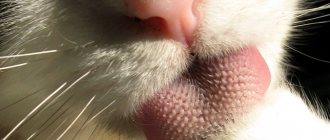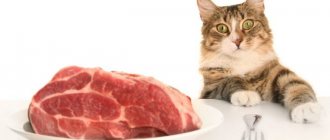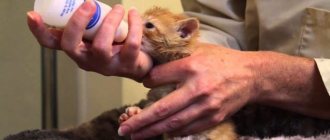A cat is a predatory animal and this causes many physiological characteristics of its body and diet. Felines, like all predators, have a special structure of teeth and jaws - fangs are designed to tear prey; they do not have root chewers, like omnivores.
Their stomach is single-chamber and is not intended for large amounts of food. The vomiting center of the brain is well developed, since females in the wild often feed their young with regurgitated masses. Felines are not scavengers; the prey they eat is always warm, which is why pets prefer non-cold food. Because of this, they have a reputation for being picky and fussy eaters. But the cat’s rejection of food, especially if it also refuses water, should alert the owner.
Reasons for refusing to eat
The cat is selective about food, sometimes even refusing its favorite treat. But refusal does not always indicate pathologies. A cat or cat may not eat for more than a day if:
- ate too much the day before;
- walk outside and eat somewhere else;
- they developed temporary digestive problems due to increased physical activity;
- they were switched to a new, unusual diet;
- the female has a week left until her heat or she is just coming;
- in the male, the rutting period is underway, he feels a female nearby;
- offended by the punishment, the owner’s inattention;
- they are given dirty dishes, spoiled food;
- The female has just given birth; on the first day (sometimes two) after they do not eat, as they have eaten a large amount of placenta.
But if a cat goes hungry for more than a day, this is already a cause for concern.
Pathological factors of food refusal:
Stress
It can be a consequence of the loss of the owner, melancholy, loneliness, fear, or other unfavorable reasons. Moving to a new apartment or house, the appearance of other pets, illness or injury always affects the psychological state of cats and provokes a refusal to eat for several days. It is not always possible to cope with this on your own; you should seek specialized help. Taking sedatives will help restore your appetite.
Also read the article on how to calm your cat.
High ambient temperature
This adversely affects the cat's appetite; heat stroke is very dangerous, since these animals do not have sweat glands. Long-haired breeds or pets with short but dense hair suffer especially from the heat. If the cat is no longer young, suffers from heart or other chronic diseases, this factor is aggravated.
Parasitic infestation
Worms, fleas, other external parasites. The cat develops vomiting and diarrhea, and its stomach becomes swollen.
If severe intoxication of the body occurs, there is a risk of rupture of the stomach, intestines and liver. In this case, deworming should be carried out under the supervision of a veterinarian.
Hairballs
They are formed as a result of licking and cause obstruction of the food tract. This problem occurs especially often in long-haired breeds. To push through the lump, there are special medications in the form of pastes.
Viral and bacterial infections
Coronavirus, rhinotracheitis, calcivirus, panleukopenia first cause a deterioration in the general condition of the animal, then primary symptoms appear in the form of sneezing, coughing, salivation and lacrimation. Refusal of food and water, dehydration usually accompany these severe pathologies. Treatment should be started immediately upon initial symptoms.
Diseases caused by pathogenic bacteria are most often secondary complications of viral infections and are accompanied by poor appetite. Treatment at a veterinary clinic is required.
Anorexia
It occurs as a result of stomatitis, dental lesions of the oral cavity, long-term use of antibiotics, and anticancer therapy. Most often it is caused by dental problems - congenital partial teeth, tartar formation, caries, and malocclusion.
Also read the article about why your cat has lost weight and what to do about it.
Systemic diseases
Bronchitis, pneumonia, pathologies of the heart, liver, and kidneys worsen the general condition of the animal, causing lethargy, apathy, and poor appetite. Specialized therapy is required.
Malignant neoplasms
Even more severe damage to the body. Anticancer therapy and sometimes surgery are required.
Urolithiasis
It is especially common cause of refusal to eat in neutered cats. Often leads to blockage of the urethra and intoxication of the body. A proper diet and constant monitoring in the clinic are important.
Poisoning
Household chemicals, rat poison, medications. The vomiting center in the cat’s brain, which is well developed due to natural features, easily provokes vomiting. This protective reaction often saves the animal’s life when dangerous substances enter the body. But from rat poison, in which the concentration of insecticides is extremely high, the cat easily dies. Every effort should be made to protect your pet from rodents. Deratization should be carried out only in the absence of pets.
Pain
Pain from injuries and wounds most often causes loss of appetite. It is necessary to alleviate the animal’s condition with the use of pain medications.
Foreign body in the food tract or stomach
This condition can lead to injuries to the gastrointestinal tract, rupture of the esophagus and stomach. Often accompanied by inflammatory processes with vomiting and diarrhea. Surgery is usually required.
The science and art of alleviating the suffering of the patient in the last days of life
Even in ancient times, people tried to help and support each other during illness and in anticipation of impending death. The dying man was surrounded by an atmosphere of mystery and solemnity. Illness and death are and always will be an inevitable part of the human experience. The maturity of that society is judged by how a society cares for children, the elderly and the dying. In order to alleviate the suffering of an incurable patient, including a dying one, palliative care (and hospice care as its component for providing care at the end of life) was born.
Palliative care is comprehensive medical and social care for patients diagnosed with an active (in the presence of symptoms requiring active medical intervention) incurable progressive disease at a stage when all possibilities for special/radical treatment have been exhausted. The main goal of such assistance is to improve the quality of life of the patient and his family, which is achieved through active identification, careful assessment and symptomatic treatment of pain and other manifestations of the disease, as well as providing psychological, social and spiritual support to both the patient and his loved ones. The principles of palliative care can be implemented at earlier stages of the disease in combination with other treatment methods [1–7].
A decisive condition for the development of palliative care is the creation of the conditions necessary to recognize the importance of the very idea of holistic care for the incurable sick and dying. It is imperative that society, including patients and their families, understand the importance of palliative care and are aware of its capabilities.
It should be noted that the new Federal Law of the Russian Federation No. 323-FZ of November 21, 2011 “On the fundamentals of protecting the health of citizens in the Russian Federation” for the first time in the history of domestic healthcare recognizes the need to develop palliative care in the country. “Palliative medical care,” the law says, “is a set of medical interventions aimed at relieving pain and alleviating other severe manifestations of the disease, in order to improve the quality of life of terminally ill citizens” (Article 36) [8]. Palliative medical care, in accordance with the law, is recognized for the first time as one of the types of medical care provided to the population. The law states that palliative care “... is provided by medical professionals trained to provide such care” (Article 36), and also about (Article 80). With the adoption of the new law, new opportunities are opening up for the development of palliative care in the regions of the country.
As the initiator of the emergence of a new direction, WHO proclaims the basic principles according to which palliative care:
- affirms life and considers death a natural, logical process;
- has no intention of extending or shortening its lifespan;
- tries to provide conditions for as long as possible so that the patient can lead an active lifestyle;
- offers assistance to the patient's family during his serious illness and psychological support during the period of bereavement;
- uses an interprofessional approach to meet all the needs of the patient and his family, including the organization of funeral services, if required;
- improves the patient’s quality of life and can also positively influence the course of the disease;
- with sufficiently timely implementation of measures in combination with other treatment methods, it can prolong the patient’s life [2].
Palliative care consists of two large components - alleviation of the patient’s suffering throughout the entire period of illness (in parallel with radical treatment) and assistance (medical, psychological, social, spiritual) in the last months, days and hours of life. It is precisely the care of the patient at the end of life in Russia that has received and still receives very little attention. It would be wrong to assume that a dying patient only needs care. In fact, there are professional subtleties of the art of alleviating the suffering of a patient that only a trained doctor and nurse can solve.
Currently, in a number of countries, “care (for the patient) at the end of life,” or hospice care (end-of-life care), is identified as an independent area of palliative care. The leading component in this direction is the formation of a special philosophy, the organization of psychological support for the patient and his family. Therefore, it is often said that palliative care and hospice as one of the forms of palliative care is not just a medical institution, it is a philosophy.
Unfortunately, doctors and nurses are not taught the art of assisting the dying. Dying patients are still ignored, medical care remains inaccessible to them, and all care falls on the shoulders of relatives and friends.
However, we must remember that some symptoms cause significant suffering to dying patients. Knowledge of basic methods for relieving symptoms in patients in the last days of life is one of the main professional requirements for a doctor of any specialty. However, simply knowing how to manage symptoms is not enough. To provide effective care to dying patients, a doctor must have a good understanding of this field of activity, as well as have the ability to communicate, make decisions and build relationships with people.
The choice of tactics to alleviate the suffering of a dying person begins, as in any section of clinical practice, with a comprehensive assessment of the patient’s condition. It is necessary to actively identify problems that may cause suffering to the patient. Such an assessment forms the basis not so much for finding solutions to individual problems, but for determining treatment goals. The assessment process can be therapeutic in itself. It enables the patient to feel that he is seen as an individual and treated with compassion.
Since symptoms are inherently subjective, the gold standard for assessment is the patient's own description of sensations and experiences. There are proven methods for assessing symptoms that can help the doctor imagine how the patient perceives a particular symptom (for example, its severity, etc.). When deciding whether to conduct diagnostic tests, one should evaluate their feasibility from the point of view of the ability to alleviate the patient’s suffering. There is no need to carry out complex diagnostics just for the sake of completing the examination standard.
Most people in the terminal stage of life experience pathological changes in affective and cognitive functions, and a range of emotions and fears arise. The fear of losing control over oneself, of being abandoned, of becoming a burden, the fear of pain and other physical suffering is often so strong that the patient has a desire to hasten the approach of death. Therefore, when talking with a patient, it is necessary to assess his emotional status, to catch signs of depression, anxiety and impaired cognitive function, since these problems can and should be corrected [9, 10].
It must be remembered that in the last days of the patient’s life, some medications should be discontinued, the use of which does not make any sense and only disrupts the patient’s comfort and may even aggravate his condition. In the last 48 hours of life, medications such as antibiotics, vitamins, iron supplements, hormones, cardiotonics, laxatives, hypoglycemic agents, diuretics, and antihypertensives can be discontinued. You can continue to administer painkillers, anticonvulsants, anticholinergics, antiemetics, and tranquilizers if necessary. That is, the patient should be provided with maximum peace, absence of pain and symptomatic relief of other painful symptoms.
There is a spiritual side to every person's life. As studies show, regardless of what is included in the concept of spirituality - a religious meaning or an individual idea of the meaning and mystery of life, the essence of being, patients are willing to talk about their spiritual problems. Although this type of assistance is usually provided by a priest, the physician must be aware that often spiritual problems can manifest themselves in the form of physical, mental or social suffering.
The physician must be able to make a preliminary assessment of the patient's social and practical needs. Unresolved relationship problems, unsettled financial, legal and practical matters can be a source of mental suffering for the patient. Since many families often spend their entire savings on treatment and care for the sick, sometimes losing their source of income, it is important to know what the patient's financial situation is. It is necessary to think about organizing practical assistance: even the most impeccable treatment plan may not give the desired results if you do not take care of the purely everyday problems of everyday life.
In the last days and hours of life, a number of physiological changes occur in the body. Each of them, if you do not understand its essence, can become a cause for alarm and make a depressing impression on relatives.
Weakness and fatigue. As the body's functions decline, the patient's weakness and fatigue increase. The patient may refuse habitual physical activity; in this case, he should not be forced to move. At this stage, most anti-fatigue medications can be discontinued. If joint movement is restricted, joint stiffness or pain may occur. Prolonged pressure on the same area of skin, especially over bony prominences, increases the risk of skin ischemia and pain. The patient needs to make a comfortable bed with pillows so that there is less need to turn around.
Stop eating and drinking. In the last days of life, patients, as a rule, completely lose their appetite and stop drinking [11, 12]. The relatives are very worried about this. However, experts believe that dehydration in the last hours of life does not cause suffering and can stimulate the release of endorphins and anesthetic substances, which improve the patient’s well-being [13–16]. In this case, low blood pressure and weak pulse are often associated with the dying process rather than dehydration. A patient who cannot stand up does not experience dizziness. With careful hygienic care of the oral cavity, nasal cavity and eye mucosa, there is no need to fear that the patient is thirsty.
In the presence of peripheral edema or ascites, excess water and salts accumulate in the patient's body, so dehydration does not occur, although the intravascular volume of fluid may be reduced due to hypoalbuminemia. Sometimes parenteral solutions are prescribed - intravenously or subcutaneously, especially if treatment of delirium is necessary.
It should be noted that parenteral fluid administration in the last days of life can have an adverse effect, which is very often underestimated by doctors. Parenteral administration of excessive amounts of fluid, especially with significant hypoalbuminemia, can lead to overload of the circulatory system with the development of peripheral edema and/or pulmonary edema, cause increased shortness of breath, cough and increased secretion of the glands of the oral cavity and tracheobronchial tree. In addition, intravenous drips cause inconvenience to the patient, especially if he is exhausted and his veins are poorly defined.
Loss of ability to swallow. If the patient cannot swallow, stop giving food and medications by mouth. Warn family members and caregivers about the dangers of aspiration. To reduce the secretion of saliva and other secretion products, scopolamine or hyoscine butyl bromide can be prescribed [17]. These medications will minimize or eliminate the noisy "bubbling" sound when breathing due to mucus buildup in the throat and trachea. Suctioning fluid from the oropharynx is often ineffective because the secretions are usually beyond the reach of the catheter. Prolonged attempts to suck out mucus can only disturb a previously calm patient and agitate nearby family members.
Neurological changes. Neurological changes associated with the dying process are caused by a number of simultaneously occurring irreversible processes. The presence or absence of such changes determines the severity of the dying process and is called by some authors the “road” to death (Fig.). Most patients follow the “ordinary road,” which is characterized by a gradual decline in consciousness, followed by coma and then death [18].
Agonical delirium. The first signal that the patient has to go along the “difficult road” to death may be the appearance of delirium with agitation. Such patients often experience confusion (disorientation), anxiety, and agitation; Sometimes there is an inversion of the sleep-wake cycle. For families and caregivers who do not understand what is happening, the sight of agonal delirium with agitation can be very distressing.
If delirium is not recognized or measures are not taken to eliminate it, then family members are likely to remember a terrible death “in terrible agony”, which, in their opinion, was probably provoked by the prescription of drugs. This will make a difficult impression on relatives, even if all previous medical care was organized flawlessly.
It is necessary to try to determine the causes of delirium and stop them. However, if the patient is in his final hours and there are other signs of the dying process, treatment should be aimed at relieving the symptoms associated with agonal delirium in order to reassure the patient and his loved ones.
When a patient's agitation and restless behavior are accompanied by groans and grimaces, this is often interpreted as evidence of physical pain [19]. However, it must be borne in mind that in the last hours of life, uncontrollable pain rarely develops or intensifies. A sign of pain may be a tense forehead, in particular the appearance of deep wrinkles on it. Terminal anxiety is distressing for conscious patients and probably also for semi-conscious patients.
If it is difficult to assess a patient who is unconscious and the doctor thinks the patient is in pain, opioids may be tried. But it must be remembered that with low renal clearance, opioids can accumulate and aggravate delirium. If a trial dose of opioids does not relieve agitation or worsens delirium by increasing agitation or precipitating myoclonic seizures, treatment should be prescribed to control symptoms associated with delirium.
Benzodiazepines are widely used to treat agonal delirium because they have anxiolytic, amnestic, and antiepileptic properties and relax skeletal muscles [19].
Pre-dissolved lorazepam for oral administration can be applied to the buccal mucosa, increasing the dose until the desired effect is obtained. It must be remembered that in some patients benzodiazepines have a paradoxical effect, causing agitation. According to some authors, antipsychotic drugs, haloperidol and chlorpromazine, do not provide adequate sedation and can lead to increased muscle tone and the appearance of convulsions [20].
Diazepam 5–10 mg may be given orally, rectally (in suppositories or by injection through a rectal tube), or intravenously (if a venous catheter is in place for other reasons), as this drug is poorly absorbed after intramuscular or subcutaneous injections. It should be given 6–12 hours later and the dose titrated to effect.
Midazolam has the advantage that it can be given by continuous subcutaneous infusion and can also be mixed in the same syringe with morphine. The usual starting dose of midazolam is 2.5–10 mg subcutaneously over 2 hours or 10–20 mg daily.
Tazepam can be administered rectally at home (in the form of temazepam capsules for oral administration). To achieve the effect in the capsules, it is recommended to first make a hole with a needle [21].
If treatment with benzodiazepines does not produce the desired result, phenobarbital should be prescribed. Start with 60–120 mg, subcutaneously every 4–8 hours, gradually increasing the dose. Once an effective dose has been achieved, the drug can be given as a continuous subcutaneous infusion, but should not be mixed with morphine or other drugs.
Terminal tachypnea. Terminal tachypnea makes a depressing impression on relatives and other patients, although the person himself is already unconscious. In particularly weakened patients, death rattles may appear against the background of respiratory movements, caused by the movement of secretions in the pharynx, trachea and large bronchi. It is believed that death rattles do not cause concern to an unconscious patient.
When terminal tachypnea occurs, it is necessary to place the patient in a side-lying position and explain the essence of what is happening to relatives and reassure them. Drugs that suppress mucus secretion are most often used as drug therapy. The drug of choice is hyoscine butyl bromide (20 mg once, then 20 mg/24 hours subcutaneously).
Weakening of the sphincters in the last hours of life can lead to urinary and fecal incontinence. Urine drainage with a catheter and the use of absorbent diapers help to minimize linen changes and hygiene procedures. However, with minimal urine output, this is not always necessary; it is often enough to use diapers. It is very important to keep the patient’s skin clean, and hygiene procedures should be carried out regularly.
The use of absorbent linen (diapers, urinary pads and absorbent diapers) will help minimize tissue injury and the need for frequent changes of linen, which will help ensure peace of mind for the patient and significantly facilitate the work of those caring for him.
The development of oligo- or anuria in the last days of life does not require examination or therapy unless it is associated with pain or increasing shortness of breath.
If those around you do not understand what is happening, what the patient’s condition is, they may be depressingly affected by the fact that the patient’s eyes are constantly open. With severe exhaustion, the volume of retrobulbar fiber decreases, and the eyeball sometimes sinks into the orbit so deeply that the eyelids are not long enough to close and close the conjunctiva completely. In this case, it is necessary to maintain the moisture of the conjunctiva using eye ointments or saline.
If a patient dies at home, then the patient’s relatives must be explained that the process of dying is as individual as the process of birth. It is impossible to predict the exact time of death and exactly how everything will happen. Tell loved ones that people facing death experience a number of similar symptoms, regardless of the type of illness.
As death approaches, certain physical and emotional symptoms appear: drowsiness and severe weakness appear and progress day by day, periods of wakefulness decrease, energy wanes; the nature of breathing changes: periods of rapid breathing are replaced by stops; Appetite worsens, the person drinks and eats less than usual, then completely refuses food and water. The urine becomes dark brown or dark red, the intestines stop emptying, or, on the contrary, involuntary stool occurs. Hearing and vision change - they do not just get worse, but on the contrary, a person can hear and see things that others do not notice. Body temperature changes; it can be elevated or, conversely, very low.
As death approaches, a person ceases to show interest in the outside world and individual details of everyday life.
If the dying person you care about sees or hears something or someone that you don't, you should agree with them—acknowledge what they see or hear. Denying these experiences can upset the dying person. Talk to the person, even if he is in a coma, hold his hand. It is known that dying people can hear even when they are in a deep coma. There is an example that people who came out of a coma said that they could hear everything that was happening while unconscious.
Principles of communication with a dying person. It is impossible to alleviate the condition of a dying person only with the help of medicines. No less important, and perhaps most important, is communication with the patient, treating him as a living person who hears and feels, needs your presence and participation until the very end. Therefore, when communicating with a dying person:
- be always ready to help;
- be patient;
- give him the opportunity to speak out, be able to actively listen;
- say a few comforting words, explain to the patient that the feelings he is experiencing are completely normal;
- be calm about his anger and dissatisfaction;
- Avoid misplaced optimism.
A dying patient needs to feel protected. He wants to be reassured, to be told that he will not suffer at the moment of dying. We need to help the patient cope with fear. We need to talk to him about his fears. You cannot pass over this topic in silence on the grounds that you cannot make him healthy again.
It is necessary to ask, listen and try to understand how the patient feels, help him finish earthly affairs, promise to fulfill his last will if he did not have time to do something himself. It is important for the patient to know that everything possible is being done for him. He should not feel isolated, should not feel that something is being hidden from him. False promises of recovery should not be used as a way to avoid talking to the patient about difficult topics.
The main help for the patient consists in constant communication with him, in living together the last period of his earthly life. A trusting relationship should be established with the patient. He must know that at the moment of death he will not be left alone and that someone will help him live through this period. In itself, our presence at the bedside of a seriously ill or dying person can have a calming effect.
The patient must be confident that he will be helped to relieve pain and other painful sensations at the time of death. Many patients need physical contact with loved ones at the time of death. They ask to be held by the hand, put a hand on their forehead, hugged, etc.
In order to help the patient cope with fear, it is necessary to be able to listen; understand non-verbal language; be able to provide emotional support; communicate with the patient openly and confidentially; treat him with compassion and respect; answer questions honestly; do not inspire unrealistic hopes; provide an opportunity to ask questions; understand the patient's needs; take into account and try to satisfy his mental, social and spiritual needs; anticipate difficulties and be prepared to overcome them.
In conclusion, I would like to quote the words of Metropolitan Anthony of Sourozh: “If I knew, if you knew that the person you are talking to could be about to die and that the sound of your voice, the content of your words, your movements, your attitude towards him , your intentions will be the last thing he will perceive and take into eternity - how carefully, how carefully, with what love we would act!.. Experience shows that in the face of death all resentment, bitterness, and mutual rejection are erased. Death is too great next to what should be insignificant even on the scale of temporary life” [22].
Literature
- Doyle D., Hanks G., MacDonald N. Introduction. Oxford textbook of Palliative Medicine. 1993. P. 3.
- WHO Definition of Palliative Care. WHO, 2007. URL: https://www.who.int/cancer/palliative/definition/en/.
- Vvedenskaya E. S., Sokolova E. G., Petrushov P. K. Palliative care: content that determines approaches to the formation of services and patient populations // Rosmedportal.com, electronic scientific and practical journal. 2012, vol. 3, p. 136–144.
- Vvedenskaya E. S. Palliative care: being with the patient to the end. Nizhny Novgorod: Publishing House NGMA, 2011.
- Vvedenskaya E. S. Palliative care is an innovative direction of modern healthcare. In the book: Current problems of chemistry, biology and medicine. Krasnoyarsk: Scientific and Innovation Center, 2011. Book. 3. pp. 5–26.
- Eckert N.V., Novikov G.A., Khetagurova A.K., Sharafutdinov M.G. Methodological recommendations for organizing palliative care. M.: MMA im. I. M. Sechenov. 2008. 58 p.
- Recommendations Rec. (2003) 24 of the Committee of Ministers of the Council of Europe to member states on the organization of palliative care. M.: Medicine for quality of life. 2005. 30 p. URL: https://pallcare.ru/ru/images/user/Ryskversion3.pdf (Date of access: 10/01/2011).
- Federal Law of the Russian Federation of November 21, 2011 No. 323?FZ “On the fundamentals of protecting the health of citizens in the Russian Federation” URL: https://www.minzdravsoc.ru/docs/laws/104 (Date of access: 02/09/2012).
- Singer PA, Martin DK, Kelner M. Quality end-of-life care: patient's perspectives // JAMA. 1999, 281: 163–168.
- Vachon M.L., Kristjanson L., Higginson I. Psychosocial issues in palliative care: the patient, the family, and the process and outcome of care // J Pain Symptom Management. 1995, 10: 142–150.
- Bruera E., Fainsinger RL Clinical management of cachexia and anorexia. In: Oxford Textbook of Palliative Medicine 2 Edition Oxford University Press, Oxford, England 1998, 548.
- Billings JA Comfort measures for the terminally ill: Is dehydration painful? // J Am Geriatr Soc. 1985, 33: 808–810.
- Ellershaw JE, Sutcliffe JM, Saunders CM Dehydration and the dying patient // J Pain Sympt Manage. 1995, 10: 192–197.
- Musgrave CF, Bartal N., Opstad J. The sensation of thirst in dying patients receiving IV hydration // J Pall Care. 1995, 11: 17–21.
- Musgrave DR Terminal dehydration: to give or not to give intravenous fluids? // Cancer Nursing. 1990, 13: 62–66.
- Twycross RB, Lack SA Therapeutics in terminal cancer, Churchill Livingstone3 Edition. 1990, 134–136.
- Frank D. Ferris, Charles F. von Gunten, Linda L. Emanuel. Ensuring competency in end-of-life care: controlling symptoms // BMC Palliative Care. 2002, 1: 5.
- Ferris FD, von Gunten CF, Emanuel LL Competency in end of life care: The last hours of living // J Palliat Med. 2003; 6:605–613.
- Shuster JL Delirium, confusion, and agitation at the end of life // J Pall Med. 1998, 1: 177–186.
- Twycross R., Lichter I. The terminal phase. In: Oxford Textbook of Palliative Medicine. 2 Edition (Edited by: Doyle D., Hanks GWC, MacDonald N.). Oxford University Press, Oxford, England, 1998, 987–988.
- Palliative care for cancer patients. Textbook edited by Professor G. A. Novikov and Academician of the Russian Academy of Medical Sciences, Professor V. I. Chissov, M.: OOD “Medicine for Quality of Life”, 2006.
- Surozhsky A. Life. Disease. Death, Publisher: Foundation “Spiritual Heritage of Metropolitan Anthony of Sourozh”, 2010, 96 p.
E. S. Vvedenskaya, Candidate of Medical Sciences
GBUZNO "Center for the Prevention and Control of AIDS and Infectious Diseases", Nizhny Novgorod
Contact information about the author for correspondence
The reason is character
All cats are picky eaters, but in some cats, due to their nature, food whims are more pronounced. A cat “with character” may not eat for more than a day due to new, unusual or tasteless food, resentment towards the owner, or a change of environment (moving to a dacha, to a new apartment). This behavior is typical for some breeds - British, Scottish fold, Sphynx.
Sooner or later, the cat will come to terms with changes in diet or environment and will begin to eat normally. It is only important that she does not stop drinking water. If a short fast does not cause significant harm to the pet’s body, then dehydration is very dangerous.
How long can a cat normally go without eating?
- healthy adult - up to five days;
- up to six months - no more than a day;
- elderly cat - up to three days;
- cat after birth - one or two days;
- after surgery (anesthesia) - up to two days;
- pregnant woman - up to two days;
- animal with chronic diseases - no more than two days.
If the hunger strike continues longer, you should make every effort to feed the animal, offering it warm food and a favorite treat. Or contact a veterinary clinic for specialist help.
Why doesn't the kitten eat?
There are many factors that influence the appetite of a small kitten. The main ones:
Stressful state
When a baby comes to a new home from a nursery, he is always torn away from his mother, his nest. He lacks the usual affection and attention, often he does not know how to take care of himself. Sometimes the move is accompanied by a complete refusal to eat and drink; the kitten may not go to the toilet even once for two days.
This condition is very dangerous, since against the background of stress, rapid dehydration and intoxication of a young body with insufficient immune defense occurs. During this period, it is important to show increased attention to the pet, surround it with love and protection, pick it up more often, and play. Offer a treat with an appetizing smell and create a comfortable environment.
New food regime
In the nursery, the baby, even receiving additional nutrition in the form of specialized formulas, still suckled on his mother. The loss of mother's milk in the diet is a shock for the kitten, both in terms of the nutritional component and psychologically.
Early weaning
Is food stress. The kitten simply does not know how to eat other food. In this case, it must be fed with cat milk substitutes, which are sold in veterinary pharmacies, or with goat milk.
Dishes
The baby refuses food because of an unusual bowl that is too bright or a plastic plate with a strong smell.
Spoiled food
Spoiled food particles also cause poor appetite.
Worm infestation and parasites
In a kitten, it is often a factor in poor appetite or complete aversion to food. The baby is losing weight, the condition of the coat is deteriorating, drooling, vomiting, and diarrhea appear. Deworming is necessary or, if the animal’s condition is of concern, observation by a veterinarian. External parasites can provoke similar factors.
Virus or other infection
The kitten refuses to eat due to inflammatory diseases of an infectious nature. The baby should be saved immediately; the pet can quickly die.
Consequences after vaccination against coronavirus
Talking about the consequences of coronavirus that can affect a person’s life in the future, one cannot help but mention the complications after vaccination against COVID-19. The vaccination campaign is gaining momentum. Despite the fierce debate among supporters for and against the coronavirus vaccine, vaccination statistics show that about 30% of the world's population has already been vaccinated.
How the vaccine works, whether you should be afraid of the consequences after vaccination against coronavirus and whether there are ways to protect yourself from complications - we will tell you further.
Coronavirus vaccine - consequences of vaccination
The injected drug familiarizes the immune system with the virus. In response to foreign invasion, the body launches immune defense. Therefore, the very first consequence of the coronavirus vaccine is swelling and redness in the injection area. This is a local reaction, it is caused by the rush of cells to the site of vaccine administration, the task of which is to prevent the spread of the disease throughout the body.
Next, the drug with the virus enters the blood. The body’s natural response is to “heat” the body to destroy the enemy, produce antibodies to fight it, and “memorize” the pathogen in order to quickly destroy it when it hits it again, preventing the development of the disease. Thus, a vaccinated person develops lasting immunity to COVID-19.
When the temperature rises, muscle weakness appears, and headache is a normal reaction. How long and how severe such consequences will appear after vaccination against coronavirus depends on the individual organism. The same infection (any kind at that) is tolerated differently by different people, so the drug itself has nothing to do with it. Often, after the vaccine is administered, no external manifestations or reactions are observed.
Vaccination against COVID-19: complications and contraindications
But do not confuse the reaction to the introduction of the vaccine with complications after vaccination against Covid. A complication is an unexpectedly serious condition that occurs after administration of the drug. Such conditions include anaphylactic shock (a sharp drop in blood pressure, cessation of oxygen supply to organs and tissues), the occurrence of convulsions, encephalitis and other serious conditions.
Similar reactions develop in those who have contraindications, but for some reason have undergone the vaccination stage. You cannot vaccinate if you have:
- chronic kidney pathologies; diseases of the cardiovascular, endocrine, hematopoietic systems; autoimmune disorders; pronounced pathologies of the central nervous system; severe allergic reactions with previously administered vaccinations.
If such pathologies are present, there is a high risk of complications after vaccination against Covid. Persons under 18 years of age, people over 65, and pregnant women cannot be vaccinated. For those who have recently suffered a severe form of coronavirus, it is also better to hold off on the vaccine, since after the illness there is an increased level of antibodies in the body. As a result of vaccination, their number will increase even more, which can cause a violent immune reaction in the body - the cytokine storm that we talked about above.
Assisting an animal when it refuses to eat
To take action, you must first understand the reasons for refusing to eat.
- If the cat does not eat the dry formula, but at the same time happily absorbs the treat, there is no reason to worry. You need to choose a constant food that your pet will eat with pleasure.
- You should carefully observe the behavior of the cat - maybe she is hunting on the street and eating her prey, or someone is feeding her. It may be necessary to limit the cat’s free movement for some time to normalize the feeding regime and diet.
- It is necessary to give the usual food in a heated form, this will certainly cause an increase in appetite in a healthy animal.
- You can try adding special dietary supplements or herbs to your diet that increase your appetite.
- If the reason for refusing food was a hormonal surge, then the situation will normalize within a week at most.
- Try to carefully drink and feed your pet liquid food through a syringe without a needle. If the animal categorically refuses to eat, there is no need to force it, you should consult a veterinarian.
When additional unfavorable factors are added to poor appetite - the cat becomes lethargic, apathetic, vomiting, diarrhea, bad breath - you cannot postpone a visit to the doctor. Most likely, this condition was caused by poisoning, infection or other pathological factors.
How to identify consequences after coronavirus
Not all patients need to go for a full examination of the body in order to identify what complications remain after Covid and whether they remain at all? Then clinics will have no time to treat patients. But some people after COVID-19 really need rehabilitation measures to eliminate the consequences. When should you seek help after you have had coronavirus?
First of all, this is poor health, a deterioration in the quality of life, and certain complaints that prevent a return to normal activities. Then you need to consult a therapist if the cause of your poor health is not clear, or go to a specialist in a narrow field with a specific complaint. The doctor must determine the direction of the study, identify the cause of the disease and take measures for rehabilitation.
When is it necessary to go to the doctor?
Be sure to consult a veterinarian if your pet has poor appetite if additional adverse symptoms are present:
- repeated vomiting;
- loose frequent stools, especially with blood;
- decreased general tone, apathy;
- complete refusal of water;
- ineffective intermittent urge to urinate or defecate;
- pain in the abdominal cavity;
- bloated belly;
- sneezing, drooling, discharge from the eyes;
- formation of dry, painful crusts on the nose and around the mouth;
- feverish condition.
How to make a cat eat
Depending on the reason why your cat stopped eating, you may be able to coax her to start eating again.
However, the quickest way to know if your cat has an appetite problem for medical reasons is to have your pet checked by a veterinarian:
- If your cat has congestion due to an upper respiratory tract condition and is unable to smell food, help clear your cat's nasal passages. If you can, put saline in her nostrils. This will clear up nasal discharge and help your cat breathe easily so she can smell the food again.
- Try heating cold wet cat food or tuna for a few seconds in the microwave. Or offer your cat canned kitten food, canned tuna, or canned chicken to whet your pet's appetite.
- Experiment by choosing cat food with a different flavor, texture, or shape.
- Make cat food from scratch. Your cat may prefer fresher, homemade ingredients.
- Check to see if the food your cat has always eaten has recently changed in taste, formula or ingredients. The information may be listed on the packaging as “new and improved flavor.” Or contact the manufacturer and ask. You may need to find a new favorite food for your cat.
Prevention
To prevent your pet from refusing to eat, the following simple measures should be followed:
- normalize diet;
- do not allow the cat to be outside uncontrolled;
- diversify your diet;
- feed the animal only premium and super-premium mixtures;
- exclude food from the human table;
- choose food in accordance with the cat’s taste preferences;
- avoid stressing the animal;
- sterilize your pet in time or provide him with a full sex life;
- carefully transfer to a new diet, especially kittens;
- prevent the animal from overheating in the hot season;
- vaccinate annually;
- regularly deworm and treat for external parasites;
- Long-haired breeds should be combed out and given pastes to prevent the formation of hairballs;
- Bring your pet to the veterinarian regularly for checkups.
1111











